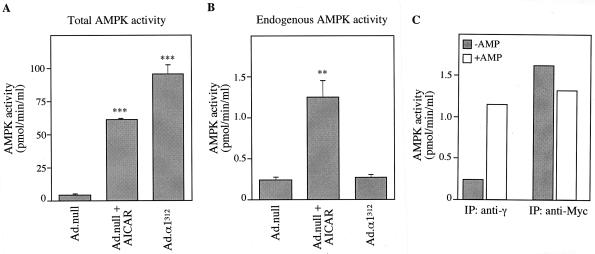FIG. 2.
Activity of α1312 in hepatocytes. Hepatocytes were grown in the presence of 25 mM glucose and 100 nM insulin and infected with either Ad.null or Ad.α1312 (30 PFU/cell). Twenty-four hours postinfection, hepatocytes were incubated in the presence or absence of 250 μM AICA riboside (AICAR) for 1 h before harvesting. (A) Total activity (endogenous AMPK and expressed α1312) was measured in cell lysates, without prior immunoprecipitation, using the SAMS peptide assay. (B) Endogenous AMPK activity was measured in immune complexes isolated by immunoprecipitation using an anti-γ antibody bound to protein G-Sepharose. (C) AMPK activity present in either anti-γ (endogenous) or anti-Myc (expressed α1312) immunoprecipitates was measured in the absence (shaded bars) or presence (open bars) of 0.2 mM AMP. Activities shown are the mean ± the SEM from four experiments (A and B) or the average of two independent experiments assayed in duplicate (C). ∗∗∗ denotes a significant difference from the Ad.null value (P < 0.0005), and ∗∗ indicates that P was <0.005. Activities are plotted as picomoles of 32P incorporation/minutes per milliliter of lysate.

